Metropolis
by Randall | August 16, 2005 10:55 am
Metropolis Committee/Sony Pictures (November 9, 2001), Columbia TriStar Home Entertainment (April 23, 2002), 2 discs (bonus is a mini-DVD), 109 mins plus supplements, 1.85:1 anamorphic widescreen, English Dolby Digital 5.1 and Japanese 5.1 DTS tracks, Rated PG-13, Retail: $24.95
Storyboard:
Osamu Tezuka’s classic manga is brought to life in a state-of-the-art animated epic. In a future society, a madman’s plan to take over is complicated by his son and a robot of his own devising.
The Sweatbox Review:
Anime lovers can point to several different touchstones where the art of animation in Japan was brought to a new level of popularity or technical accomplishment. Anime’s oldest and perhaps most beloved character is known in North America as Astro Boy, and the 1988 film Akira is most often pointed to as THE film that brought modern “Japanimation” to the notice of the mainstream in North America. Imagine, then, what fans of those works thought when it was announced that an old comic book by Astro Boy creator Osamu Tezuka was going to be brought to the big screen thanks to a screenplay by Akira creator Katsuhiro Otomo in 2001. The result was even more spectacular than fans might have expected, as the resulting Metropolis offered a stunning melding of cel and computer-generated animation while telling a complex story filled with politics, explosions, and metaphysics.
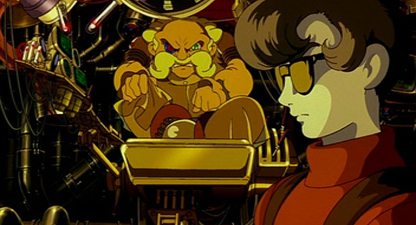
Osamu Tezuka was a pioneering comic book artist and later animator, of which Metropolis was one of his early serialized works (recently available in a nifty little digest from Dark Horse Comics). It was named for the famous silent sci-fi film by Fritz Lang, although at the time Tezuka had not seen it. A character in the story Tezuka created for his manga posited that any species that becomes too advanced will perish. In the “Summer of 19xx”, there is fear in Metropolis of The Red Party, led by Duke Red. Duke Red forces one Dr. Lawton to create a synthetic being, but before the being can be brought to life, Lawton destroys the lab and disappears along with the artificial human. The two resurface a few months later, and the reader finds out that the being can be either male or female. The reappearance of Lawton and his creation comes to the attention of Duke Red, who finds Dr. Lawton once again. Detective Mustachio from Japan interrupts their meeting, but Lawton is killed. Discovery of Lawton’s will leads to the revelation of the existence of the androgynous (but initially more male) “Michi”. Coincidentally, Mustachio’s nephew Kenichi has already befriended the artificial person, so it is not long before the detective finds Michi.
After joining some fellow lawmen (including Sherlock Holmes), Mustachio eventually finds an underground hideout for the Red Party and meets a robot named Fifi who explains that all the slave robots there hate Duke Red. Mustachio is captured by Duke Red, and learns that the Red Party is responsible for creating black spots on the sun, and that they are creating a lethal gas, all with the intention of raising Earth’s temperature. With the Earth being pummeled with radiation from sunspots, mutations begin to appear, including an army of giant rats named “Mikimaus Waltdisneus”, looking just like you-know-who. The story also features a flower-selling girl named Emmy, some mobsters, and the partial destruction of Metropolis at the hands of an enraged, now-female Michi.
It is a neat little story, although hampered by lapses of logic and inconsistent storytelling in respect to time. It was nevertheless a large success, although Tezuka himself was unimpressed by it in later years.
Don’t worry; I did not just spoil the film for you. The film, in fact, is vastly different from the manga.

Years ago, a director named Rintaro, who worked in Tezuka’s own animation studio, asked him about making Metropolis into a movie. Tezuka, not being fond of his old work, refused. Rintaro was deterred for a time, but a few years after Tezuka’s death he brought his idea to Katsuhiro Otomo, the celebrated creator of both the manga and anime versions of Akira. Together, they fleshed out the story, sticking more to the themes and ideas than the actual plot points. It was their intent to create a spectacular movie that encompassed the notions seen in Tezuka’s work, but with a greater depth and structure than what was seen in the manga version.
In the film version, Duke Red is a popular figure in Metropolis, best known for being responsible for the building of a huge construct called the Ziggurat— a device whose purpose is a mystery, but is still celebrated as mankind’s greatest technological achievement. It is well known that Duke Red is the founder and financer for a group known as the Maldukes, a political party whose members supposedly act as vigilantes to combat anti-robot sentiment in their society—- although what we see is the Maldukes destroying malfunctioning robots. (One wonders if there was a problem with the translation here.) The film reflects the manga more when it comes to Duke Red’s coercion in having Dr. Laughton (new spelling) create a synthetic being. The being’s purpose here is to ultimately take control of the Ziggurat. She is presented as clearly female, and is given the name of Tima.
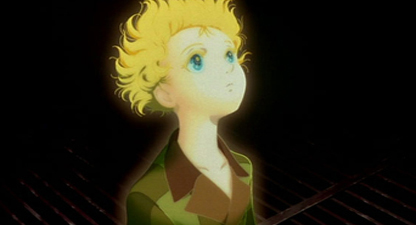
Meanwhile, the movie’s version of Mustachio, Shansaku Ban, comes from Japan to look for Dr. Laughton, who is wanted in relation to crimes involving the bodily organ black market. His nephew Kenichi tags along to assist the investigation.
Rock is a character not in the manga, but is a central character in the movie. He is a young man in charge of security for Duke Red, and as an orphan he sees Duke Red as a father figure. When he finds out that Duke Red is having a synthetic “daughter” created to control the Ziggurat, he explodes with jealousy. He makes it his mission to have Tima destroyed, thinking it will end the “evil” of the robots and preserve his bond with Duke Red.
In its portrayal of the city of Metropolis, the film owes a debt to Fritz Lang’s own film of a future society. Like the Lang movie, Metropolis here is shown to be a city of many levels, where the supreme beauty of the city above lies in sharp contrast with the lower levels, home to society’s rabble, as well as the power plant and sewage system. It is in the lower levels that Shansaku Ban and Kenichi seek out Dr. Laughton, but they arrive only after the doctor is killed and his new creation, the “robot” Tima, goes missing. Essentially similar to the manga, Tima is befriended by Kenichi. Kenichi immediately develops affection for Tima, but the central question of the movie is whether or not an artificial being like Tima can reciprocate love. This becomes of utmost importance in the film’s finale, when Tima holds the future of mankind in her hands.
The story takes on even greater scope when it branches out to a subplot involving the military’s and government’s responses to the threat of Duke Red and his Ziggurat, especially after black spots appear on the sun. The presence of revolutionaries below Metropolis also seems to promise to affect the outcome, but it may be that Duke Red has it all under control. The only thing he cannot control is the budding sentience of his robot…
At times, the film almost seems to overreach itself, threatening to be overwhelmed with all the competing factions, biblical allusions, and metaphysical questions. It all manages to hang together, though, and makes for a very involving 109-minute viewing experience. True, a few of the plot points could have been clearer, such as the goals of the Maldukes, but one still manages to get swept up in the story enough to forgive some minor haziness in the details. Metropolis is a true achievement visually as well, expertly mixing cel animation and CGI effects. Certainly, one can often tell where the CGI effects are placed, but only because the effects would have been impossible with hand-drawn animation. The three-dimensional buildings and mechanical devices, along with particular attention to shading on the hand-drawn animation, give the film a spectacular visual depth that make Metropolis stand well above most animated features. My first time viewing the movie, I found it difficult to follow the story just because I was too busy gawking at the visuals. Congratulations to the production team, including the animation house, Madhouse Productions.
Now that I’ve watched the film a couple of times, I can see a few shortcomings. The questions raised in the film, regarding robot sentience, have been raised before and probably in more interesting ways. Also, I personally always find it tough to get behind the whole “robots are people too” idea— fun in Star Wars, but I cannot take the notion of a true debate seriously. The plot involving several soon-to-be-warring factions seems underdeveloped and presented a little late in the game. Lastly, the finale seems uncomfortably close to Otomo’s own Akira, showing a potential apocalypse, in the midst of martial law, at the hands of a near-omnipotent being. Nevertheless, this film’s reputation as a landmark in anime is well deserved.
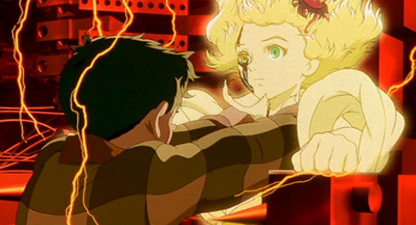
The animation is expertly accomplished and smoother than most anime films, but still a little stilted. Nevertheless, the staging and layouts are magnificent, and the backgrounds are densely detailed. I think you will be too amazed by the total look of the film to be worried about the number of drawings per second.
The film is rated PG, but it is not nearly as violent as Akira. Some children will have no problems dealing with images of destruction that come up in the finale (my toddler loved the movie), but more sensitive kids should perhaps stick with some of Miyazaki’s gentler films for the time being.
Is This Thing Loaded?
The first disc offers only Trailers, for Metropolis, Final Fantasy: The Spirits Within, Cowboy Bebop, and Roughnecks: The Starship Troopers Chronicles.
The real goodies are to be found on the second disc, a rare example of using a 3” DVD rather than the customary 5” version. Despite the smaller disc size, I doubt anyone would be disappointed by what they find here. Photo Gallery is a minor example, but there are a number of nice character and prop designs to be viewed here. Animation Comparisons offers two multi-angle sequences from the film depicting several stages of production.

The most comprehensive treat is Animax Special: The Making Of Metropolis (33:15). This comprehensive featurette runs in 4:3 video, in Japanese but with English subtitles. It offers just about everything you would want in such a production. It reveals the budget (a steal at $15 million!) and has interviews with the writer, director, several artists, the composer, and few of the (Japanese) voice actors. Perhaps the most interesting part of the featurette is where Otomo and Rintaro describe what they think Tezuka would have thought of their film— they feel he probably would have hated it! I wasn’t sure how much they were joking when they said that. It seems certain, however, that Tezuka would not have been crazy with the idea of making the film, given that he had rejected the idea in the past.
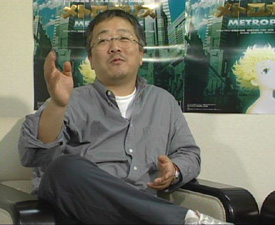
Filmographies really offers histories of Rintaro and Otomo, giving us a little more history on their backgrounds as filmmakers. History Of Metropolis is more text, but well worth reading; more background is given on the manga as well as the film, and how Tezuka’s other works influenced the writing of the movie.
Lastly, Filmmaker Interviews (8:04) gives us more insight from Rintaro and Otomo, specifically talking about using CGI in the film, and doing the film without Tezuka’s permission.
Short of a true commentary track, I cannot say what might be missing from these special features. And as I (and most Region 1 viewers) don’t understand a word of Japanese, it’s just as well that there is no commentary track!
Case Study:
The discs are held in a beautifully designed digipack whose design aesthetics seem influenced by the Japanese. The only thing missing is a slipcover, making the packaging seem somewhat unfinished.
Ink And Paint:
This is one lush-looking film, and thank goodness the transfer is up to the task. The 16:9 anamorphic transfer is just beautiful, with no artifacting that I could notice. The image is perfectly crisp, and considering all the pans and zooms I was very impressed with the lack of shimmering. Reference. Quality.
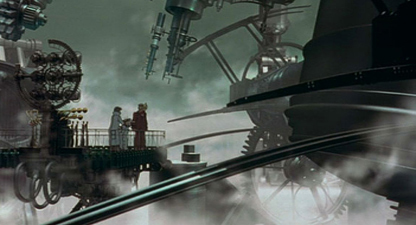
Scratch Tracks:
The New Orleans jazz-styled music, with lapses into big-band territory, is an odd but interesting choice, and this is just one part of a stimulating aural experience. The sound design is quite well rounded, offering something for every speaker in your set-up.
You have an interesting choice to make when deciding which track to listen to, though. The clearest, most satisfying track offering the most sonic depth (and best acting) is certainly the Japanese DTS soundtrack, but if you watch the movie with subtitles it does distract you from enjoying the visuals (or vice versa). You may wish to watch the movie in English 5.1 Dolby Digital first to grasp the plot without the distraction of subtitles, and then later watch it with the Japanese DTS track to get the most out of the movie.

If you prefer to listen to the original Japanese but do not have DTS capability, there is also a fine Japanese 5.1 Dolby Digital track that mirrors the English one for quality— that is, very good but just not quite as fine as the DTS track. There is also a French Dolby Surround track available.
Subtitles that can be accessed include English, French, Spanish, Portuguese, Chinese, Korean, and Thai. There are actually two options for an English subtitle track: you may read the original Japanese translation, or the US theatrical version to see what was changed to make a smoother transition between languages. Mostly, the changes are minor re-phrasings, but there is the odd clarification or illumination to be found when viewing one subtitle track or the other.
Final Cut:
Stunning graphics make this a joy to watch, and although the script offers little new it is still a step above most films in its complexity and interest. If you love animation as an art form, this is a must-see; and unlike many other “eye candy” movies, this one offers enough substance to keep you from feeling empty afterwards. The terrific bonus features make this a great purchase as well.
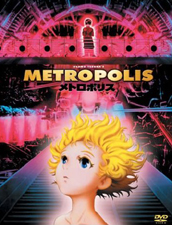 | ||
 [1] [1] |
- [Image]: http://www.amazon.com/exec/obidos/ASIN/B00005V4XG/animatedviews-20
Source URL: https://animatedviews.com/2005/metropolis/